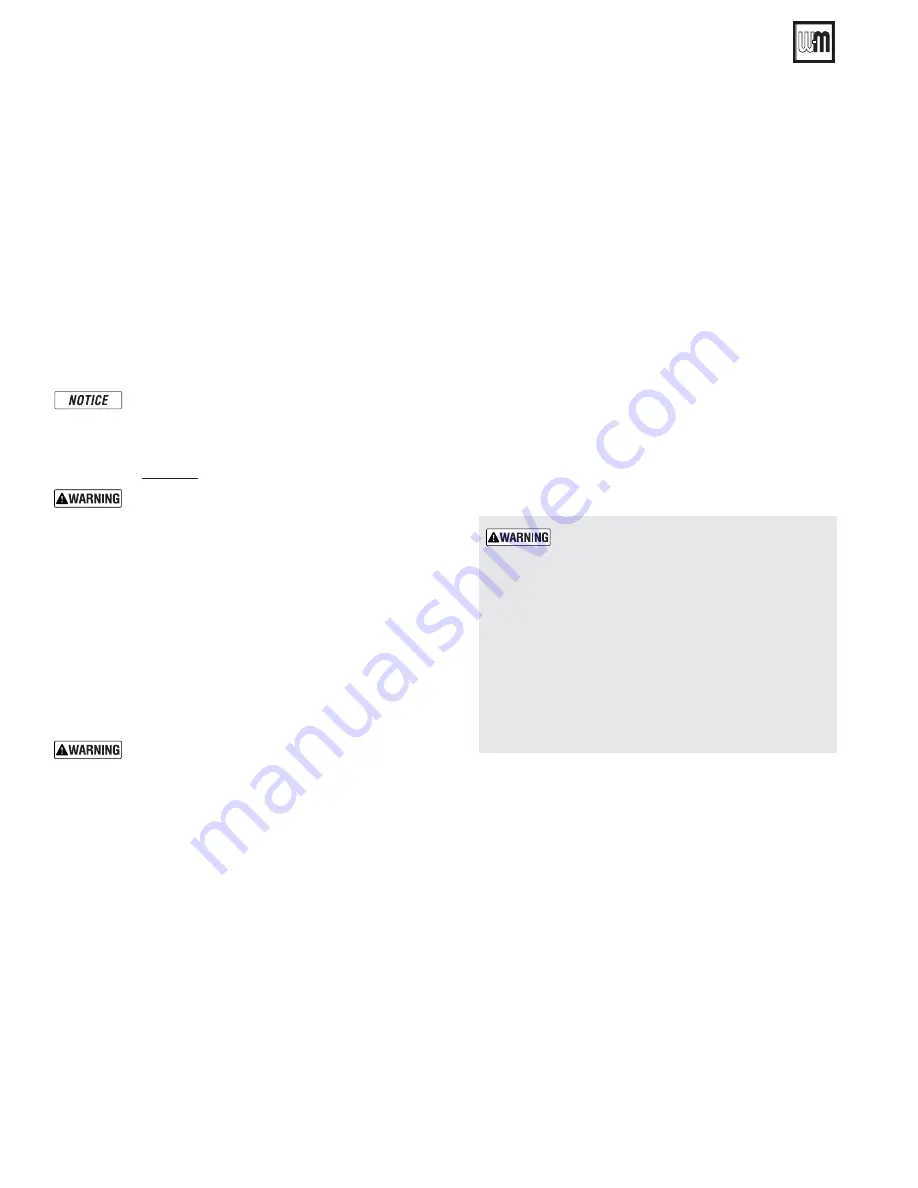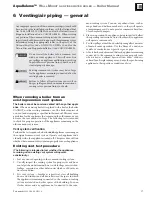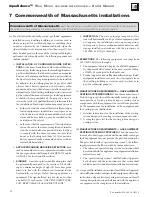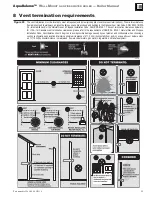
Part number 550-100-305/0118
6
AquaBalance
TM
W
ALL
M
OUNT
GAS
-
FIRED
WATER
BOILER
—
Boiler Manual
Codes and Checklists:
Installations must comply with:
•
Local, state, provincial, and national codes, laws, regulations and
ordinances.
•
National Fuel Gas Code, ANSI Z223.1/NFPA 54 - latest edition.
•
National Electrical Code ANSI/NFPA 70 – latest edition. Electrical
installation and grounding must be in accordance with CSA C22.1,
Part 1, Canadian Electrical Code, and/or local codes.
• For Canada only: CAN/CSA B149.1, Natural Gas and Propane
Installation Code, and any local codes.
•
Where required by the authority having jurisdiction, the installa-
tion must conform to the Standard for Controls and Safety Devices
for Automatically Fired Boilers, ANSI/ASME CSD-1.
Certification
The boiler gas manifold and controls met safe lighting
and other performance criteria when boiler underwent
tests specified in ANSI Z21.13 — latest edition.
Flooring
1. The
boiler
must not
be installed on carpeting.
Do not install boiler on carpeting even if foundation
is used. Fire can result, causing severe personal injury,
death or substantial property damage.
Before locating the boiler:
1. Wall construction — Make sure the wall construction is
suitable to carry the weight of the boiler and components.
See page 9 for instructions.
2. The boiler is suitable for INDOOR installation only.
3. Check for nearby connection to:
• System water piping
• Venting connections
• Gas supply piping
• Electrical power
• Condensate drain
4. Check area around boiler. Remove any combustible materials,
gasoline and other flammable liquids.
Failure to keep boiler area clear and free of combustible
materials, gasoline and other flammable liquids and
vapors can result in severe personal injury, death or
substantial property damage.
5. The boiler must be installed so that gas control system components
are protected from dripping or spraying water or rain during
operation or service.
6. If new boiler will replace existing boiler, check for and correct
system problems, such as:
• Sediment or corrosion in system piping — clean and flush piping
BEFORE connecting the new boiler. See page 70.
• System leaks causing oxygen corrosion or heat exchanger cracks
from hard water deposits.
• Incorrectly-sized expansion tank.
• Lack of freeze protection in boiler water causing system and
boiler to freeze and leak.
Residential garage installation
Precautions
1. Take the following special precautions when installing the boiler in
a residential garage. If the boiler is located in a residential garage:
• Mount the boiler with its burner and igniter are at least
18 inches above the floor. Follow the National Fuel Gas Code,
ANSI Z223.1 for U. S. installations, or Natural Gas and Pro-
pane Installation Code, CSA B149.1 and B149.2 for
Canadian installations.
• Locate or protect the boiler so it cannot be damaged
by a moving vehicle.
•
Ensure that the installation complies with all applicable
codes.
•
Prevent boiler water and condensate from freezing.
Provide air openings to room
Boiler alone in boiler room
1. No air ventilation openings into boiler room are needed if
clearances around boiler are at least equal to the SERVICE
clearances shown in Figure 2, page 7.
2. For spaces that DO NOT supply the minimum service clear-
ances, provide two openings as shown in Figure 2, page 7.
Each opening must provide 1 square inch free area per
1,000 Btuh of boiler input.
2 Prepare boiler location
The space must be provided with combustion/
ventilation air openings correctly sized for all
appliances located in the same space as the
boiler.
Reinstall boiler jacket door after servicing. The
boiler jacket door must be securely fastened
to the boiler to prevent boiler from drawing
air from inside the boiler room. This is par-
ticularly important if the boiler is located in
the same room as other appliances.
Failure to comply with the above warnings
could result in severe personal injury, death
or substantial property damage.
Boiler in same space with other gas or
oil-fired appliances
1. Follow the sizing requirements shown in Figure 24, page 22.
Vent and air piping
1. The boiler requires a special vent system, designed for
pressurized venting. Boilers are rated ANSI Z21.13
Direct Vent (pressurized vent, likely to condense in the
vent). See instructions beginning on page 17.
2. You must also install air piping from outside to the
boiler air intake adapter. The resultant installation is
categorized as direct vent (sealed combustion). Note
prevention of combustion air contamination on page 8
when considering vent/air termination.
3. Vent and air must terminate near one another unless
otherwise specified in this manual. Vent and air piping
may be routed vertically through the roof or out a side
wall, following the options give in this manual. You may
use any of the vent/air piping methods covered in this
manual. Do not attempt to install the boiler using any
other means.
4. Be sure to locate the boiler such that the vent and air
piping can be routed through the building and properly
terminated. The vent/air piping lengths, routing and
termination method must all comply with the methods
and limits in instructions beginning on page 17.







































